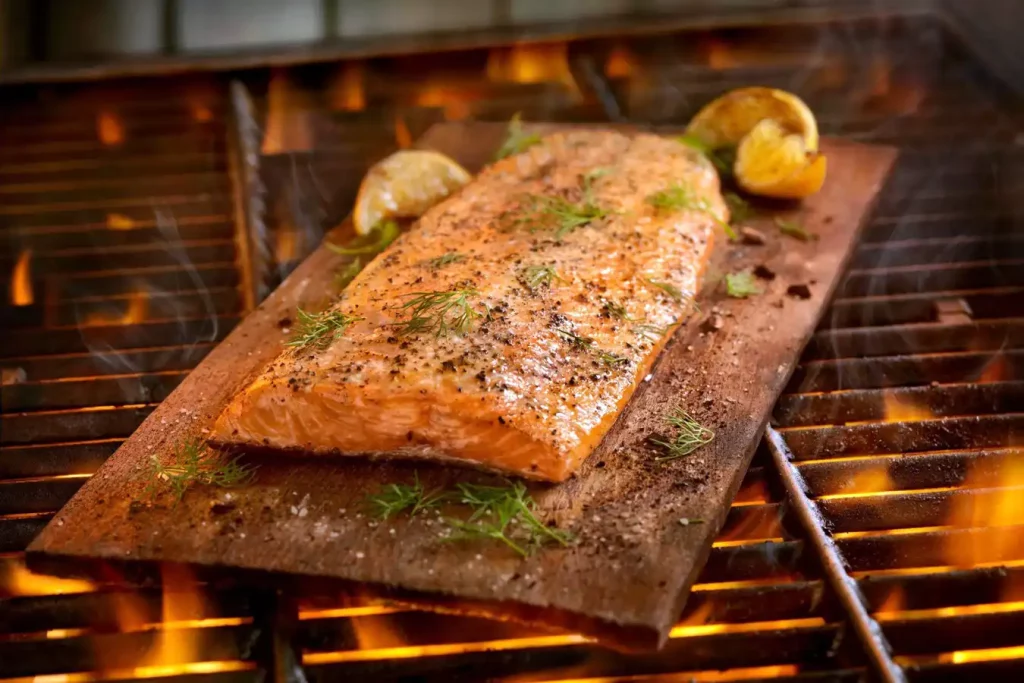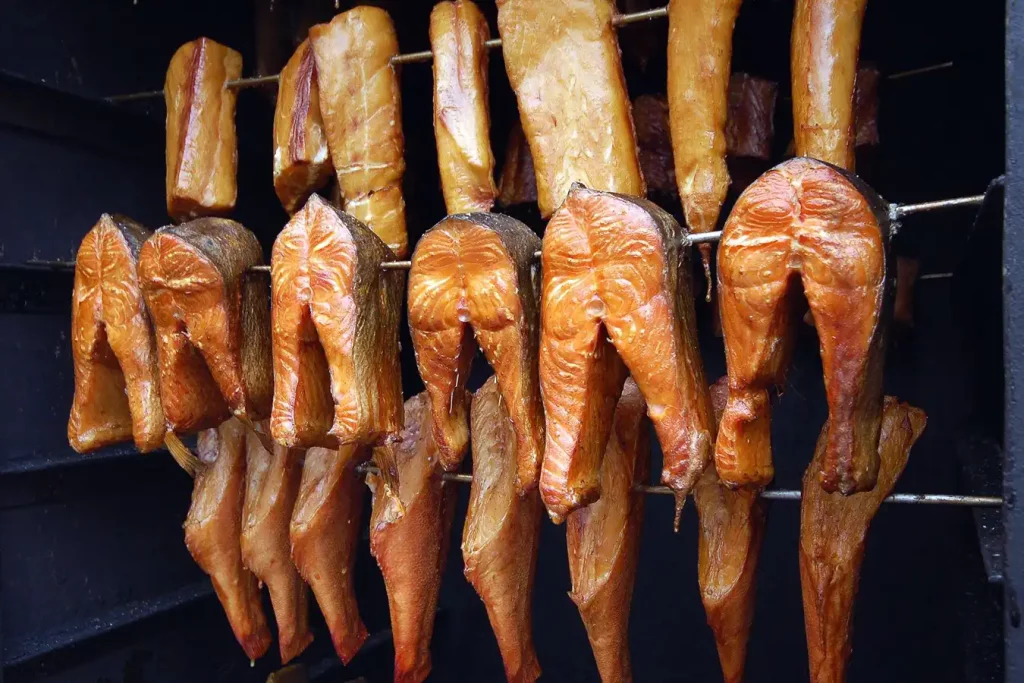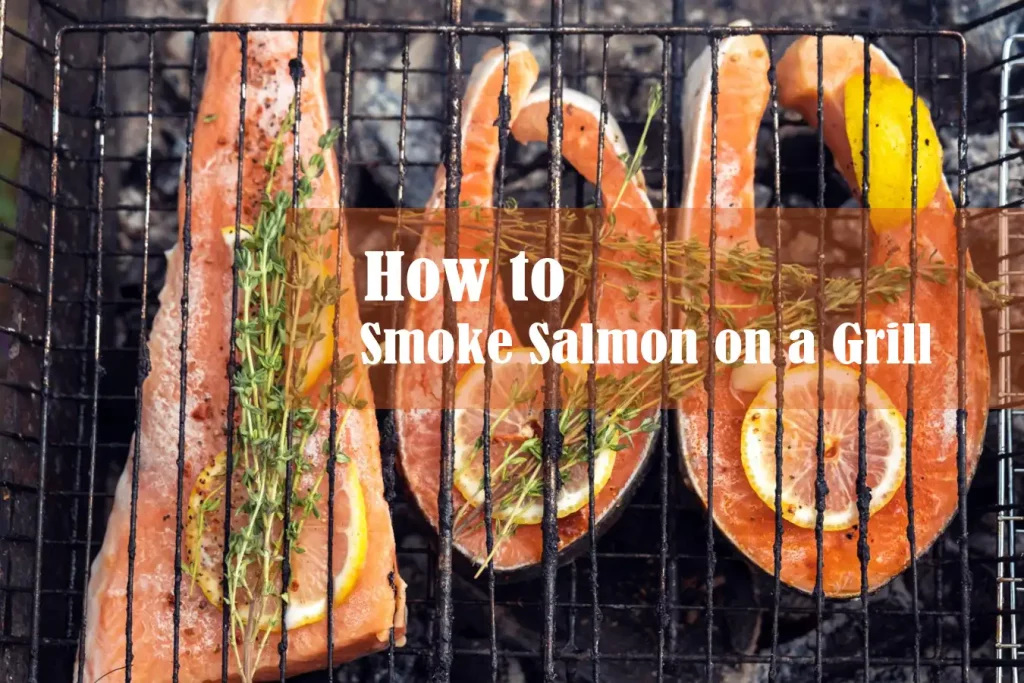Ever pondered how to smoke salmon on a grill to create an unforgettable BBQ experience?
You’ve landed in the right place.
As an outdoor enthusiast and devoted blogger, I’m here to share my passion for unique campfire flavors.
This article will guide you through the steps to smoking salmon, bringing the outdoor camping experience to your backyard.
Expect handy tips, secret tricks, and a culinary journey that’s about to level up your BBQ game.
Let’s dive in, and get ready to smoke your best salmon yet!
Understanding the Basics of Smoking Salmon
Before we jump into our smoked salmon journey, let’s take a moment to understand the basics of smoking fish. This centuries-old method of preservation has evolved into a fine culinary technique that can transform a simple piece of fish into a gourmet masterpiece. But why does it work so well with salmon? And how does it differ from grilling? Let’s find out!
How Smoking Works and Why It’s Perfect for Salmon
Smoking is essentially a two-part process: curing and, well, smoking. Curing is when we salt the fish to draw out moisture, creating an environment where bacteria cannot thrive. This step not only aids preservation but also enhances the texture of the fish. It’s a bit like marinating, with the salt infusing into the flesh and intensifying the flavor.

Next comes the actual smoking, which involves cooking the fish slowly and gently in a cloud of smoke. The smoke infuses the salmon with a unique, rich flavor that’s simply incomparable. Now, why salmon? Well, the robust and somewhat fatty nature of salmon holds up beautifully to the intense flavor of smoke. The fat content keeps the salmon moist during the smoking process, ensuring a delectably juicy end result.
Grilling vs. Smoking: Key Differences
Now, you might be wondering, “Isn’t that similar to grilling?” Well, not quite. While both grilling and smoking involve cooking over a fire, there are key differences.
Grilling is a high-heat method that cooks food quickly, ideal for searing steaks or charring veggies. But smoking, on the other hand, is a game of patience. It’s a low-and-slow method, gently cooking the food at a low temperature over several hours. This slow dance with the fire allows the smoke to deeply penetrate the salmon, imparting a flavor that grilling just can’t replicate.
Preparations Before Grilling
Just like any culinary endeavor, the road to smoking salmon on a grill starts with preparation. This isn’t just about getting your apron on and firing up the grill – it’s about choosing the right salmon, gathering your ingredients and equipment, and setting the stage for a successful smoking session. Let’s break it down.
Choosing Your Salmon
The star of our show is, of course, the salmon. Choosing the right salmon can make all the difference in your smoked salmon adventure. First and foremost, look for fresh salmon. Freshness is key in achieving the best flavor and texture.
The type of salmon also matters. While there are many varieties, King (Chinook) and Sockeye salmon are particularly great for smoking, thanks to their high fat content and rich flavor. If possible, choose wild-caught over farmed, not only for sustainability reasons but also for superior taste and texture.
Ingredients and Equipment
Once you’ve got your perfect salmon, it’s time to gather your ingredients and equipment. In terms of ingredients, you’ll need the basics for a brine (more on that in a moment), typically salt, sugar, water, and your choice of herbs or spices. Feel free to get creative here, as the brine can significantly influence the flavor of your smoked salmon.
As for equipment, you’ll need a grill (gas or charcoal both work), a bag of wood chips (for that smoky flavor), a grill thermometer to monitor the temperature, and a brush for applying the brine. Don’t forget a good pair of tongs for handling the salmon!
Preparing the Salmon
Now that we’ve chosen our salmon and gathered our ingredients and equipment, it’s time to roll up our sleeves and start preparing the salmon. This involves making the brine and soaking the salmon in it. But why brine, you ask? Let’s dive in.
Making the Brine
Brining is an essential step in smoking salmon. It helps to enhance the flavor, retain moisture, and improve the texture of the salmon. Essentially, it prepares the salmon to be smoked, helping it withstand the lengthy smoking process without drying out.
Making a brine is simple. A basic brine consists of water, salt, and sugar in a 4:1:1 ratio. For example, you might use 4 cups of water, 1 cup of salt, and 1 cup of sugar. You can also add herbs or spices to the mix. Try adding some garlic, peppercorns, dill, or lemon peel for extra flavor. Bring the brine to a boil, then let it cool before using.
Brining the Salmon
Once your brine is cooled, it’s time to soak your salmon. Submerge the salmon in the brine, ensuring it’s fully covered. Then, place it in the refrigerator and let it soak for at least 6-8 hours, or even overnight. This gives the brine enough time to work its magic, infusing the salmon with flavor and moisture.
Preparing Your Grill
With your salmon soaking in brine, your grill may feel left out. But fear not, its time is coming. Getting your grill ready for smoking is a crucial step. It involves choosing the right wood for that quintessential smoky flavor and setting up the grill properly. Here’s how you go about it.
Choosing the Right Wood
The wood you use for smoking can significantly influence the flavor profile of your salmon. Different types of wood impart different flavors, and not all are suitable for smoking fish. For salmon, you’re looking for woods with a mild, sweet, or fruity flavor that won’t overpower the fish.
Some top choices include alder, apple, cherry, and maple. Alder is traditional for smoking salmon, especially in the Pacific Northwest, where both alder and salmon are plentiful. Apple and cherry give a slightly sweet, fruity smoke, while maple imparts a mild, sweet flavor. Avoid stronger woods like hickory or mesquite, as they can dominate the salmon’s taste.
Setting Up Your Grill for Smoking
Now, onto the grill setup. To smoke salmon, you’re aiming for a “low and slow” approach, which means maintaining a low temperature over a long period. Aim for a temperature of around 225°F (107°C) if you can control your grill’s heat. If your grill has a built-in thermometer, that’s perfect. If not, a standalone grill thermometer can be a handy tool.
To set up your grill for smoking, you’re going to use a method called indirect grilling. This means the salmon isn’t directly above the heat source, allowing it to cook slowly and absorb the smoky flavor from the wood chips.
If you’re using a gas grill, turn on half the burners and place the wood chips in a smoker box over the lit burners. The salmon will go on the other side of the grill. If you’re using a charcoal grill, place the lit coals on one side and the salmon on the other.
Soak your chosen wood chips in water for about 30 minutes before placing them on the grill. This helps them smolder and produce that delicious smoke, rather than burning up quickly. Once your grill is preheated and the wood chips are smoking, you’re ready to get grilling!
How to Smoke Salmon on a Grill: A Step-by-Step Guide
We’ve chosen our salmon, made our brine, soaked our wood chips, and set up our grill. Now comes the pièce de résistance – smoking the salmon! This step-by-step guide will navigate you through the smoking process.
Step 1: Preheating the Grill and Adding the Wood Chips
First things first, preheat your grill to about 225°F (107°C). While it’s warming up, drain your wood chips that have been soaking in water. If you’re using a gas grill, place the wood chips in a smoker box or an aluminum foil pouch with holes poked in the top. For a charcoal grill, you can sprinkle the wood chips directly on the coals.
Step 2: Placing the Salmon on the Grill, Skin-Side Down
Remove your salmon from the brine, giving it a quick rinse under cold water to wash away any excess salt. Pat the fish dry with paper towels. This step is essential for getting that nice, smoky crust.
Once your grill is preheated and you see smoke wafting from your wood chips, it’s showtime. Place your salmon on the grill grates, skin-side down, on the side of the grill opposite the heat source (remember, we’re using indirect heat).
Step 3: Monitoring and Maintaining the Temperature
Close the lid of the grill and let the magic happen. Maintain a consistent temperature of 225°F (107°C) throughout the smoking process. On a charcoal grill, you might need to add more briquettes every hour or so to keep the temperature steady.
Avoid the temptation to frequently open the grill lid to check on your salmon. Every time you do, you lose heat and smoke, both of which are essential for the best-smoked salmon.
Step 4: Checking for Doneness: Visual Cues, Flaking, Internal Temperature
So, when is smoked salmon done? There are several signs to look for. The most accurate way is to use a digital thermometer to check the internal temperature. When it reaches 145°F (63°C) at the thickest part of the fish, your salmon is perfectly cooked.
However, keep in mind that many people, especially smokehouse professionals, prefer their smoked salmon a bit less done, usually around 125°F (52°C). This leaves the salmon more moist and tender.

Visual cues are another way to determine if your salmon is ready. The fish will become opaque, and the flesh will begin to flake when gently prodded with a fork.
Learn more: How to Grill Sockeye Salmon
Post-Smoking Procedures and Serving Suggestions
Now that your salmon is beautifully smoked, it’s time for the final touch-ups before you can sit back and relish your hard work. Let’s cover how to let your salmon rest for optimal flavor and texture, how to cut it, and some serving suggestions.
Letting the Salmon Rest for Optimal Flavor and Texture
You might be eager to slice into that smoky, delicious-looking salmon right away, but patience is key here. Allow your smoked salmon to rest for about 10 minutes after you remove it from the grill. This allows the juices to redistribute throughout the fish, enhancing both the flavor and texture.
Cutting and Serving Suggestions
When it’s time to cut your salmon, use a sharp knife and slice against the grain. This will help ensure your pieces are tender rather than tough and chewy.
As for serving, smoked salmon is versatile. Serve it as a main course with some roasted vegetables and a side of wild rice, or flake it onto a fresh salad. Smoked salmon also makes for great hors d’oeuvres – just add some cream cheese, capers, and a squeeze of lemon onto a slice of rustic bread, and voila!
Pairings: Sauces, Sides, and Drinks that Complement Smoked Salmon
Smoked salmon has a rich, bold flavor, so it pairs well with lighter, citrusy sides and sauces. Lemon-dill sauce is a classic pairing, and a cucumber salad lightly dressed with vinegar and dill can provide a refreshing contrast.
As for drinks, if you’re a wine enthusiast, a glass of chilled Pinot Gris or Sauvignon Blanc complements the smoky, savory flavor of the salmon perfectly. Beer lovers, on the other hand, might enjoy a nice, light Pilsner.
Troubleshooting and Tips
While the smoking process can seem complex and intimidating, remember – practice makes perfect. Here’s a quick rundown of potential issues that you might encounter and how to address them:
- Temperature fluctuations: If you’re struggling with maintaining a consistent temperature, remember to adjust the vents on your grill. A wider opening lets in more oxygen, which stokes the fire and raises the temperature. Conversely, closing the vents reduces oxygen, cooling the grill.
- Salmon looks done on the outside but is raw inside: This could mean your heat is too high. Try lowering the temperature, and remember, smoking is a ‘low and slow’ process.
- Salmon is too salty: If your salmon turns out too salty, the brine concentration may have been too high, or the brining time was too long. Adjust these factors in your next attempt.
FAQs about Smoke Salmon on a Grill
How long grill salmon burgers?
Grill salmon burgers for about 4-5 minutes per side on medium heat until they reach an internal temperature of 145°F.
How to smoke salmon on a charcoal grill?
For smoking salmon on a charcoal grill, maintain a low temperature of around 200-225°F, place soaked wood chips on the coals, and smoke the fish indirectly on the grill for approximately an hour or until it reaches an internal temperature of 145°F.
How long to grill salmon burgers on gas grill?
Salmon burgers should be grilled on a preheated gas grill at medium heat for about 4-5 minutes on each side, or until the internal temperature reaches 145°F.
How long to cook salmon on a Weber grill?
On a Weber grill, salmon fillets or steaks should be cooked over medium heat for approximately 8-10 minutes per inch of thickness or until the fish flakes easily with a fork.
How to grill salmon on a Blackstone?
To grill salmon on a Blackstone griddle, preheat the griddle to medium-high heat, place the seasoned salmon fillets skin-side down, and cook for 3-4 minutes on each side, or until the fish is opaque and flakes easily.
How long to grill salmon patties?
Salmon patties typically take about 4-5 minutes to grill per side on medium heat, until they are golden brown and reach an internal temperature of 145°F.
How long to cook salmon on a George Foreman grill?
A George Foreman grill will typically cook salmon fillets in 4-6 minutes due to its dual-sided grilling capability. Check for doneness by confirming the fish is opaque and flaky.
How long to cook salmon burgers on grill?
Grill salmon burgers for approximately 4-5 minutes on each side on medium heat, or until the burgers reach an internal temperature of 145°F. Always ensure they are fully cooked before serving.
Final Thoughts about Smoke Salmon on a Grill
And there you have it! Now you’re equipped with all the knowledge you need to smoke salmon like a pro, right in your backyard. You’ve learned not just the steps involved, but also the science behind them and why each is crucial. We’ve also shared tips to enhance your grilling experience and addressed some potential issues you might encounter. But what’s next?
The answer is simple: Practice. The beauty of smoking salmon, or any form of cooking really, lies in the fact that it’s both a science and an art. The more you practice, the more you’ll be able to understand the nuances of your grill, the nature of your ingredients, and how they all come together to create the final product.
So, now it’s your turn to don the chef’s apron. Whether you’re a beginner or a seasoned griller, I hope this guide inspires you to try something new and exciting, and that the process of smoking salmon brings as much joy to you as the final dish itself.
Remember, the journey is just as important as the destination. So embrace the learning curve, the smoky aroma of wood, the sizzling sound as the salmon hits the grill, and the sweet reward of a job well done when you finally sit down to taste your masterpiece.
Don’t forget to share your experiences and your own tips in the comments below! Sharing knowledge and learning from each other is what makes grilling and smoking a community experience, even if we’re doing it in our individual backyards.
So, go ahead, fire up that grill, and let the smoking begin. Here’s to delicious, smoky, melt-in-your-mouth salmon grilled to perfection. Happy grilling, folks!
To know more: How to Get More Smoke Flavor From Pellet Grill


